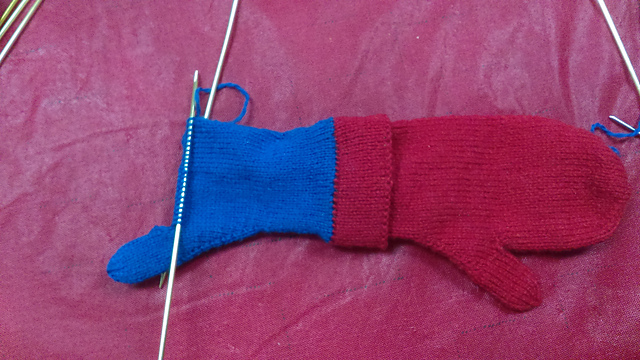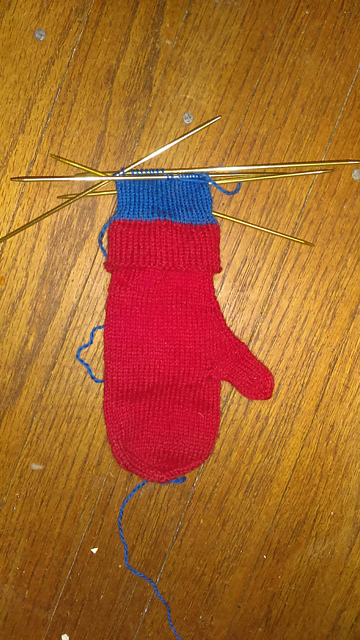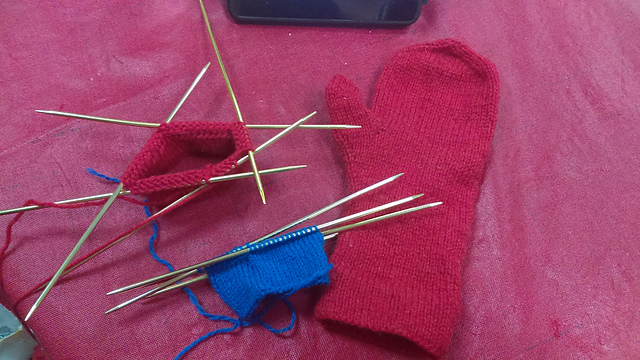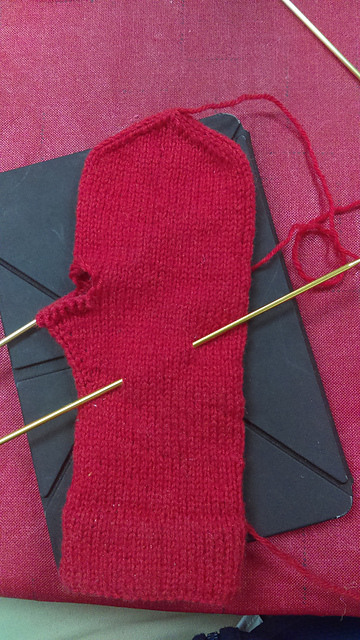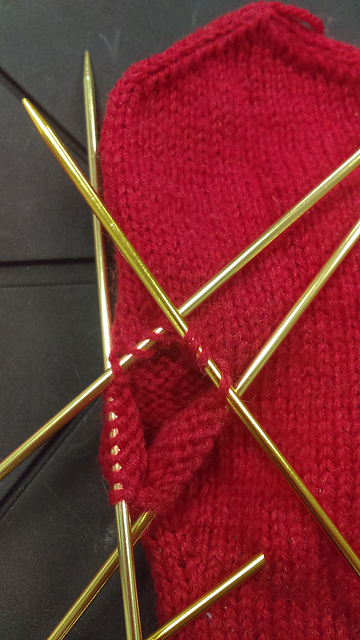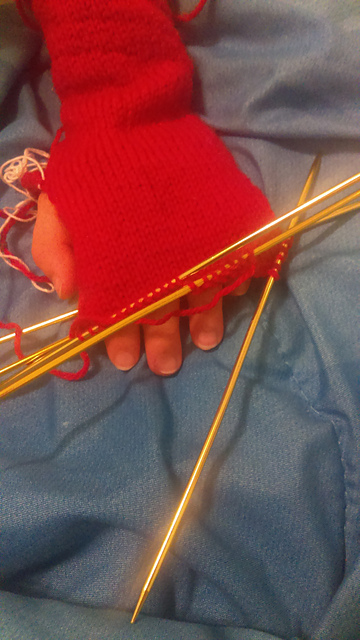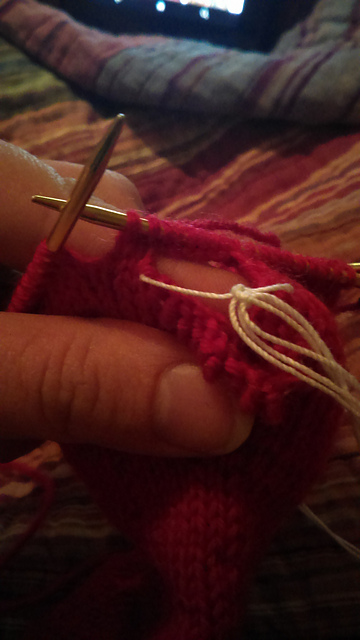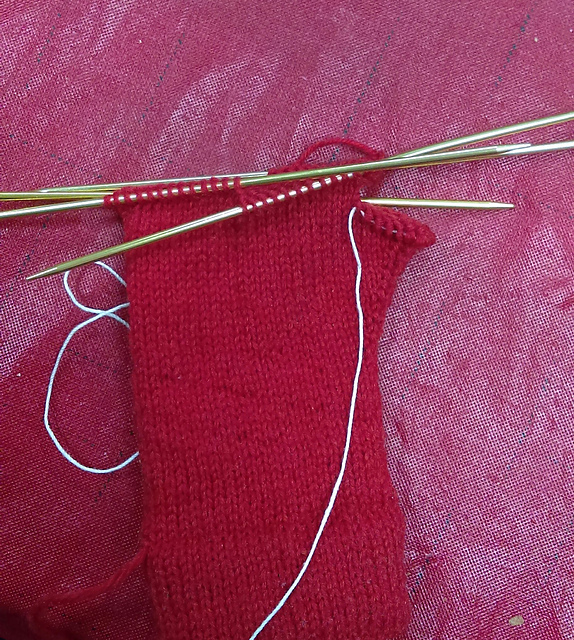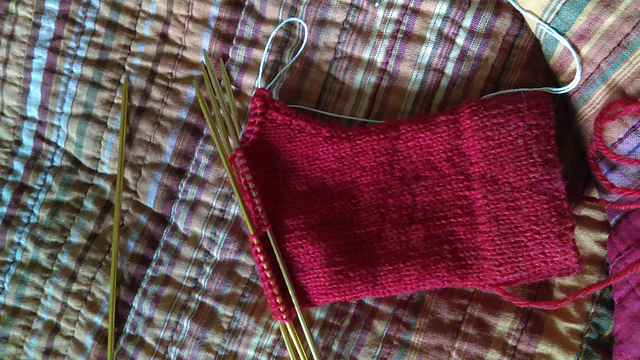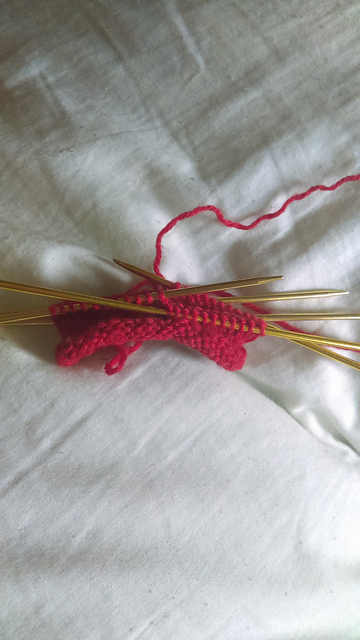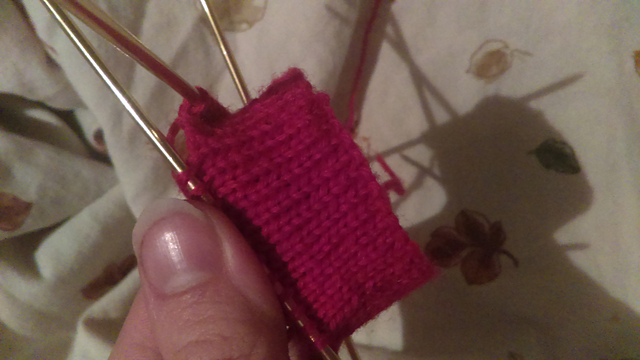My oh my what a wonderful day
Plenty of sunshine heading my way
Zippity-do-dah zipping-ay
I am so happy to be done with this zany blog schedule.
Saturday, April 30, 2016
Friday, April 29, 2016
Y is for Young and restless
Youth is perhaps not to blame for my yarn infidelity, but whatever the reason, my heart has certainly gone astray from this project.
Yarn-related pursuits that are not mittens:
This Civil War sock:
This Lucy Neatby sock from her free Craftsy class:
This crazy crochet washcloth:
This beaded shawlette that I unearthed from deep in the unfinished object collection:
Yes, I have been faithless. Yet I do promise to finally complete the pair, at least by next fall, since they aren't just display pieces -my son really will be wearing them.
Yarn-related pursuits that are not mittens:
This Civil War sock:
 |
| My car knitting |
This Lucy Neatby sock from her free Craftsy class:
 |
| My bedtime knitting |
This crazy crochet washcloth:
 |
| Starts with a thread mesh, then you crochet ruffles into it. Why not? |
This beaded shawlette that I unearthed from deep in the unfinished object collection:
 |
| Sparkly |
Yes, I have been faithless. Yet I do promise to finally complete the pair, at least by next fall, since they aren't just display pieces -my son really will be wearing them.
 |
| There you are |
Thursday, April 28, 2016
X is for Xerox
Ideally, the second mitten should be an exact copy of the first, but in that quixotic ideal universe, I didn't make any mistakes on the first mitten.
With that in mind, I'll be taking extra care to avoid the extra stitches and decreases that so vexed me the first time around.
My expectation is that I will find exciting new errors instead.
With that in mind, I'll be taking extra care to avoid the extra stitches and decreases that so vexed me the first time around.
My expectation is that I will find exciting new errors instead.
Wednesday, April 27, 2016
W is for What have We learned?
Well, the month is winding down and my will to keep working on these mittens is dwindling, but not yet extinguished. What have We learned in the course of these whacky and wonderful four weeks?
-Swatches lie.
-Math is hard
-I can't count
-The inner dimensions of the mitten are more important than the outer dimensions
-I can't knit two fully lined mittens from scratch in a month, even child-sized ones
-Wool is really nice to work with
-Swatches lie.
-Math is hard
-I can't count
-The inner dimensions of the mitten are more important than the outer dimensions
-I can't knit two fully lined mittens from scratch in a month, even child-sized ones
-Wool is really nice to work with
Tuesday, April 26, 2016
V is for Vivisection
One of the issues with the completed mitten is that the outer thumb is not long enough to accommodate the inner thumb. My strategy to solve this vexing problem is to chop open the top, rip back to before the thumb decreases, put it back on needles and knit it up with fresh yarn until it's long enough.
I'm waiting until I've finished the second mitten to actually attempt this, so there are no pictures yet.
I may also chop the top of the inner mitten main body and knit it longer, because there's almost half an inch of space between its top and the top of the outer mitten, but we'll see; maybe that can be fixed with blocking instead of the more violent proposed mad surgery.
I'm waiting until I've finished the second mitten to actually attempt this, so there are no pictures yet.
I may also chop the top of the inner mitten main body and knit it longer, because there's almost half an inch of space between its top and the top of the outer mitten, but we'll see; maybe that can be fixed with blocking instead of the more violent proposed mad surgery.
Monday, April 25, 2016
U is for Upside-down and inside-out
The inner mitten is complete, and can be tucked up inside the outer mitten.
Unfortunately, there are a couple of flaws that will need to be dealt with before the mitten is ultimately wearable, but that will be an undertaking for another day. For now, things are looking up.
Sunday, April 24, 2016
T is for Troubleshooting Thumbs
Time for a helpful tip. Typically when picking up stitches around the thumb, whether they're for the thumb or the hand, you end up with a little hole between the picked up stitches and the original live stitches. This can be remedied somewhat by picking up an extra stitch in that space and decreasing it away on the next round, but sometimes that isn't enough and there's still a gaping hole.
The good news is that you have a built-in darning thread - the tail from where you joined the yarn. Before you go to weave in that end, use it to sew up the hole, and the trouble is gone.
Tada!
In other news, the top decreases worked out perfectly.
The good news is that you have a built-in darning thread - the tail from where you joined the yarn. Before you go to weave in that end, use it to sew up the hole, and the trouble is gone.
Tada!
In other news, the top decreases worked out perfectly.
Friday, April 22, 2016
S is for Stumped
So it should have worked to pick up seven stitches at the thumb cast-on, work around, decrease twice, work around, decrease once more, and have 48 stitches, but somehow I ended up with an extra stitch, but since it isn't going to show and I'm so sick of late night math sessions, I just threw in an extra decrease, and I'll sort it out in the second mitten before I set out to actually write up the pattern.
This screenshot sums up my feelings so well.
This screenshot sums up my feelings so well.
 |
| Seriously. So done. |
Thursday, April 21, 2016
R is for Reverse Order
It was recommended to me that I work the lining thumb before the rest of the mitten rather than after, and I can see the reason in it - it would be really fiddly trying to pick up stitches with only a toddler-sized thumb-width worth of room to maneuver in.
`
The needles I'm using are too long for this tiny thumb, though, so the process is still very fiddly, and sometimes it feels like I'm trying to juggle a pincushion.
I'm not really sure that I'm doing this right, to be honest, but I forge ahead nonetheless. After finishing the last gusset increase row, I worked up to the eight gusset stitches, then used a new needle to knit those eight stitches, and another new needle to cast on four more stitches. Finally I took a third needle and joined the (20) thumb stitches in the round, and worked one round plain. On the next round, I knit to the last stitch, and then knit it together with the first stitch of the next round. In that next round, I decreased twice, and then once more in the following round, in rather random order, but the end result was 16 stitches. I knit 10 rounds, then k2tog around twice until 4 stitches remained, cut the yarn, drew through the remaining stitches twice, and wove in the tail.
`
The needles I'm using are too long for this tiny thumb, though, so the process is still very fiddly, and sometimes it feels like I'm trying to juggle a pincushion.
I'm not really sure that I'm doing this right, to be honest, but I forge ahead nonetheless. After finishing the last gusset increase row, I worked up to the eight gusset stitches, then used a new needle to knit those eight stitches, and another new needle to cast on four more stitches. Finally I took a third needle and joined the (20) thumb stitches in the round, and worked one round plain. On the next round, I knit to the last stitch, and then knit it together with the first stitch of the next round. In that next round, I decreased twice, and then once more in the following round, in rather random order, but the end result was 16 stitches. I knit 10 rounds, then k2tog around twice until 4 stitches remained, cut the yarn, drew through the remaining stitches twice, and wove in the tail.
Wednesday, April 20, 2016
Q is for Quick
Quickly is how the lining is working up, and quick is what this post must be. No time for quibbling! Any questions?
Quick quiz!
What was Ma's maiden name?
Quick quiz!
What was Ma's maiden name?
Tuesday, April 19, 2016
P is for Picking up Stitches
As previously mentioned, in preparation for this post I swatched with my new Knit Picks yarn to see what size needles I would potentially be using to pick up the stitches for the lining. I was pleasantly surprised to find that I could just keep using the size 2 needles I used for the main body of the mitten - with the fingering weight they provided me with 9 stitches per inch, precisely the gauge I wanted. It should allow me to pick up the same number of stitches so that I could just keep to the pattern and create what is basically a slightly smaller mitten attached to the inside of the main mitten for an extra layer of warmth and wind protection.
Here is where I pick up my stitches.
This is the cuff turned inside out. See the line of right-leaning stitches, right below? Starting at the beginning of the round (discernible by the little bump of the slip-knot that was the start of my cast-on row), I insert my needle into each leaning stitch and knit into it using the lining yarn, until I have 44 stitches picked up, all the way around.
Just keep knitting, just keep knitting . . .
Up, up, up. Hopefully the row gauge works out as well, otherwise I'll have to engage in some jiggery-pokery with the numbers to figure out how to make the the gusset, thumb, and decreases fit properly into place, but that's fodder for another post, and I'm perfectly pleased to procrastinate.
Here is where I pick up my stitches.
This is the cuff turned inside out. See the line of right-leaning stitches, right below? Starting at the beginning of the round (discernible by the little bump of the slip-knot that was the start of my cast-on row), I insert my needle into each leaning stitch and knit into it using the lining yarn, until I have 44 stitches picked up, all the way around.
Just keep knitting, just keep knitting . . .
Up, up, up. Hopefully the row gauge works out as well, otherwise I'll have to engage in some jiggery-pokery with the numbers to figure out how to make the the gusset, thumb, and decreases fit properly into place, but that's fodder for another post, and I'm perfectly pleased to procrastinate.
Monday, April 18, 2016
O is for On the Other hand...
I'm oddly optimistic about completing these mittens by the close of the month, but for that to be even remotely likely, I'm going to have to really open the throttle. So not only am I swatching for the lining on mitten number One...
I've also cast on and made headway on the other mitten.
Obviously I'm operating under absurd delusions of the amount of free time I actually have, but that has always been the case, so...
Onward!
I've also cast on and made headway on the other mitten.
Obviously I'm operating under absurd delusions of the amount of free time I actually have, but that has always been the case, so...
Onward!
Saturday, April 16, 2016
N is for Not Done Yet
The new yarn for the lining arrived today!
I'll need to do some swatching to see what size needle and how many stitches I'll need to pick up to make a lining that fits neatly inside the mitten. In the meantime, there are a few things I need to deal with on said mitten.
Those nefarious, nauseating, noodly ends.
Normally I wait until the very end of a project to even think about weaving in ends, but because these mittens will be lined, the ends need to be tucked away as I go or there will be nowhere to put them. Ends are most invisible when woven in on the wrong side of the fabric, and the wrong sides will be hidden inside the linings once all is said and done.
Needs must.
Now, the good news is that there are only four ends altogether, the absolute minimum on a mitten (starting yarn, top tail, starting yarn on the thumb (not shown in the picture), thumb tail), since at no point did I have to join a second color or a new ball. Bonus good news - I weighed the finished mitten, including ends, and it weighs exactly 25 grams, and since it was knitted from a 50 gram ball of yarn, that means there is exactly enough yarn left to make the second mitten with the same number of ends - I won't run short and have to join a new ball of yarn.
So I'll break out my darning needle, and see you all on Monday.
 |
| Knit Picks Palette, "Blue," 100% wool, fingering weight |
Those nefarious, nauseating, noodly ends.
Normally I wait until the very end of a project to even think about weaving in ends, but because these mittens will be lined, the ends need to be tucked away as I go or there will be nowhere to put them. Ends are most invisible when woven in on the wrong side of the fabric, and the wrong sides will be hidden inside the linings once all is said and done.
Needs must.
Now, the good news is that there are only four ends altogether, the absolute minimum on a mitten (starting yarn, top tail, starting yarn on the thumb (not shown in the picture), thumb tail), since at no point did I have to join a second color or a new ball. Bonus good news - I weighed the finished mitten, including ends, and it weighs exactly 25 grams, and since it was knitted from a 50 gram ball of yarn, that means there is exactly enough yarn left to make the second mitten with the same number of ends - I won't run short and have to join a new ball of yarn.
So I'll break out my darning needle, and see you all on Monday.
Friday, April 15, 2016
M is for Mittens
M marks the middle of the alphabet, and midway point of this month's challenge. The main body of the first mitten is done; there's just some making up to be managed before I either start on the lining or make the second mitten. As far as the knitting goes, I'm only 1/4 of the way through, considering that second mitten and the two linings, but the design work is basically finished. If I decide I'm happy with it, I could theoretically write up the pattern now, except that I've never knit a mitten lining before, so I figure I'd better do that before I discover any major catastrophes along the way.
For today, meanwhile, I'm giving myself a break.
For today, meanwhile, I'm giving myself a break.
The three little kittens, they lost their mittens,
And they began to cry,
"Oh, mother dear, we sadly fear,
That we have lost our mittens."
"What! Lost your mittens, you naughty kittens!
Then you shall have no pie."
"Meow, meow, meow."
"Then you shall have no pie."
The three little kittens, they found their mittens,
And they began to cry,
"Oh, mother dear, see here, see here,
For we have found our mittens."
"Put on your mittens, you silly kittens,
And you shall have some pie."
"Purr, purr, purr,
Oh, let us have some pie."
The three little kittens put on their mittens,
And soon ate up the pie,
"Oh, mother dear, we greatly fear,
That we have soiled our mittens."
"What, soiled your mittens, you naughty kittens!"
Then they began to sigh,
"Meow, meow, meow,"
Then they began to sigh.
The three little kittens, they washed their mittens,
And hung them out to dry,
"Oh, mother dear, do you not hear,
That we have washed our mittens?"
"What, washed your mittens, then you're good kittens,
But I smell a rat close by."
"Meow, meow, meow,
We smell a rat close by."
Thursday, April 14, 2016
L is for Like a sore thumb
Look! It's almost a mitten!
Let's get down to business to create the thumb.
My first step is to transfer the stitches on the waste yarn back onto needles. In doing so, I discovered that I had 15 thumb stitches, instead of 16. This solves the mystery of why I had an extra stitch when I finished decreasing for the top of the mitten. Apparently I literally can't count. Thanks a lot, first grade.
Now I need to pick up the stitches around the open space. Typically one picks up a stitch in each of the cast-on stitches (6), and one in the gap between the live stitches and the picked-up stitches (so 8 altogether, in this case). Because I'm short a stitch anyway, I've picked up an extra stitch where the gap is particularly wide, which should help prevent the holes that are likely to occur around thumb bases. Normally I would pick up these new stitches with the working yarn as I went, but I decided to try picking up the loops from the existing fabric first, just to see how it goes.
I don't like it any better than I ever like picking up stitches (which is not at all, ever), but it works well enough.
I join my working yarn at the first picked-up stitch and work around to the last live stitch, which I work together as a k2tog with the first new stitch, to further help closing the gaps from picking up stitches. I do the same with the last picked-up stitch and the first live stitch as I continue, and keep decreasing on either side until I have 16 stitches left. This whole section is a leap of faith for me - I'm not really sure how the thumb is going to end up fitting, especially with the lining inside. Trial and error, like everything else I've done so far . . .
The rest of the thumb is knit plain until it reaches the top of my son's thumb, then I will k2tog around until there are 4 stitches left, cut the yarn (leaving an eight inch tail) and draw through the stitches twice to secure.
Let's get down to business to create the thumb.
My first step is to transfer the stitches on the waste yarn back onto needles. In doing so, I discovered that I had 15 thumb stitches, instead of 16. This solves the mystery of why I had an extra stitch when I finished decreasing for the top of the mitten. Apparently I literally can't count. Thanks a lot, first grade.
Now I need to pick up the stitches around the open space. Typically one picks up a stitch in each of the cast-on stitches (6), and one in the gap between the live stitches and the picked-up stitches (so 8 altogether, in this case). Because I'm short a stitch anyway, I've picked up an extra stitch where the gap is particularly wide, which should help prevent the holes that are likely to occur around thumb bases. Normally I would pick up these new stitches with the working yarn as I went, but I decided to try picking up the loops from the existing fabric first, just to see how it goes.
I don't like it any better than I ever like picking up stitches (which is not at all, ever), but it works well enough.
I join my working yarn at the first picked-up stitch and work around to the last live stitch, which I work together as a k2tog with the first new stitch, to further help closing the gaps from picking up stitches. I do the same with the last picked-up stitch and the first live stitch as I continue, and keep decreasing on either side until I have 16 stitches left. This whole section is a leap of faith for me - I'm not really sure how the thumb is going to end up fitting, especially with the lining inside. Trial and error, like everything else I've done so far . . .
The rest of the thumb is knit plain until it reaches the top of my son's thumb, then I will k2tog around until there are 4 stitches left, cut the yarn (leaving an eight inch tail) and draw through the stitches twice to secure.
Wednesday, April 13, 2016
K is for Kitchener who?
Knitting lore claims that Lord Kitchener, in addition to raising armies for WWI, also rallied the knitters and submitted a pattern for a better sock for the soldiers, featuring a new way of closing the toe - grafting - that didn't leave the bulky, uncomfortable seam that the old method made.
There's absolutely no evidence that the Earl Kitchener had anything to do with the advent of grafting sock toes, but it's still known as Kitchener stitch today, and it's not just for sock toes. It creates an invisible join between two sets of live stitches anywhere you might want such a seam, including mitten tops.
Unfortunately, Horatio Herbert Kitchener popularized this method around 1915, so our mitten top isn't going to be Kitchenered.
Sorry, K is a really hard letter.
After ripping out my mitten top and reknitting it, I found that I was once again left with an odd number of stitches - 9 instead of 8. Glaring at the mitten made no change, so I opted to just ignore the odd stitch and soldier on. It's what Field Commander the Right Honorable Kitchener would have wanted.
The historical knitter we're trying to copy may have been frustrated with her mittens, too, since it looks like she ended up using two different methods of closing up the tops. The mitten on the left was pretty obviously decreased down to a very few stitches and then cinched up through them, and the one of the right was probably finished with a three-needle-bind-off when there were about 16-18 stitches left.
With only 9 stitches on my needles, it made the most sense to lasso them up, so I cut my yarn, leaving a long tail, and then used a darning needle to thread the tail through the remaining stitches, and pulled tight. The end result was a little pointy, but acceptable.
That finishes the main body of the mitten.
 |
| Think of all the mittens I could have been working on while I was messing around with this poster on MS Paint |
There's absolutely no evidence that the Earl Kitchener had anything to do with the advent of grafting sock toes, but it's still known as Kitchener stitch today, and it's not just for sock toes. It creates an invisible join between two sets of live stitches anywhere you might want such a seam, including mitten tops.
Unfortunately, Horatio Herbert Kitchener popularized this method around 1915, so our mitten top isn't going to be Kitchenered.
Sorry, K is a really hard letter.
After ripping out my mitten top and reknitting it, I found that I was once again left with an odd number of stitches - 9 instead of 8. Glaring at the mitten made no change, so I opted to just ignore the odd stitch and soldier on. It's what Field Commander the Right Honorable Kitchener would have wanted.
The historical knitter we're trying to copy may have been frustrated with her mittens, too, since it looks like she ended up using two different methods of closing up the tops. The mitten on the left was pretty obviously decreased down to a very few stitches and then cinched up through them, and the one of the right was probably finished with a three-needle-bind-off when there were about 16-18 stitches left.
With only 9 stitches on my needles, it made the most sense to lasso them up, so I cut my yarn, leaving a long tail, and then used a darning needle to thread the tail through the remaining stitches, and pulled tight. The end result was a little pointy, but acceptable.
That finishes the main body of the mitten.
Tuesday, April 12, 2016
J is for Just like a sock, and oh, Joy! More math
My mitten is just about at the top of my son's pinkie, so we're just about ready to jump into the top-shaping! Judging by the Pinterest mittens, this should be accomplished using paired decreases, just like a flat toe on a sock.
For paired decreases, you make right-leaning decreases on one side of the front of the mitten, and left-leaning decreases on the other side of the front, and repeat on the back, for neatly symmetrical shaping. The right-leaning decrease is always knit-2-together (k2tog), and the period-correct left-leaning decrease is slip 1 knitwise, knit 1, pass-slipped-stitch-over (s1, k1, psso).
Right- or left-leaning refers to the way the decreased stitch lies, not necessarily which side they're on. If you put right-leaning decreases on the right side and left on the left, it creates a continuous line of stitches that frames the curve of the edge. Right-leaning stitches placed on the left side and left-leaning stitches on the right are subtler, as they lean into the edge. The latter is the effect shown in the historical sample, so that's what I'm using.
So onto rate of decrease. There's an inch difference between the top of the pinkie and the top of the middle finger, where the mitten will stop, and each decrease row will subtract four stitches. Let's say I was to decrease every other round. At 10 rounds to the inch, that's 5 decrease rounds, or 20 stitches subtracted from the starting 48. I'd be left with 28 stitches to close, 14 stitches each front and back, and a mitten top just under 2" wide. Too wide, I think. Decreasing every round would leave eight stitches, which should make a more nicely rounded top.
Here is my sequence, then:
Needle 1: K1, k2tog, knit to end of needle
Needle 2: Knit to last three stitches, s1, k1, psso, k1
Repeat for needles 3 and 4
Repeat entire sequence every row until there are 8 stitches remaining (two on each needle).
Or, in my case, forget to keep one stitch before and after each end of the decreases, miss a decrease somewhere, end up with nine remaining stitches, rip back entire section.
I wonder if Ma wasn't ever tempted just a little bit to swear at her knitting, too.
For paired decreases, you make right-leaning decreases on one side of the front of the mitten, and left-leaning decreases on the other side of the front, and repeat on the back, for neatly symmetrical shaping. The right-leaning decrease is always knit-2-together (k2tog), and the period-correct left-leaning decrease is slip 1 knitwise, knit 1, pass-slipped-stitch-over (s1, k1, psso).
Right- or left-leaning refers to the way the decreased stitch lies, not necessarily which side they're on. If you put right-leaning decreases on the right side and left on the left, it creates a continuous line of stitches that frames the curve of the edge. Right-leaning stitches placed on the left side and left-leaning stitches on the right are subtler, as they lean into the edge. The latter is the effect shown in the historical sample, so that's what I'm using.
So onto rate of decrease. There's an inch difference between the top of the pinkie and the top of the middle finger, where the mitten will stop, and each decrease row will subtract four stitches. Let's say I was to decrease every other round. At 10 rounds to the inch, that's 5 decrease rounds, or 20 stitches subtracted from the starting 48. I'd be left with 28 stitches to close, 14 stitches each front and back, and a mitten top just under 2" wide. Too wide, I think. Decreasing every round would leave eight stitches, which should make a more nicely rounded top.
Here is my sequence, then:
Needle 1: K1, k2tog, knit to end of needle
Needle 2: Knit to last three stitches, s1, k1, psso, k1
Repeat for needles 3 and 4
Repeat entire sequence every row until there are 8 stitches remaining (two on each needle).
Or, in my case, forget to keep one stitch before and after each end of the decreases, miss a decrease somewhere, end up with nine remaining stitches, rip back entire section.
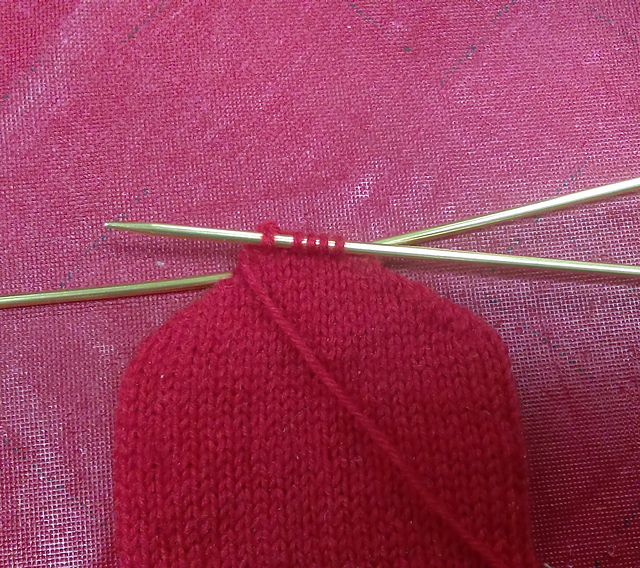 |
| Five mocking stitches where there should be four |
I wonder if Ma wasn't ever tempted just a little bit to swear at her knitting, too.
Monday, April 11, 2016
I is for Inching along...
I don't know why this part seems so interminable, perhaps because I keep stopping to measure. I said at the end of the last entry that I had about three inches to knit before I start the decreases for the top - that is incorrect. Three inches is roughly the length from the wrist to the top of my four-year-old's pinkie, and a chunk of that is already in place from working the gusset. Mathematical errors are inevitable; I've never been interested in the subject.
It is incredibly difficult to get a four year old boy to keep his hand still. The actual measurement was a shade under 2.5 inches from the cast-on stitches at the gusset, or 7.375 inches from the bottom edge of the cuff.
It is incredibly difficult to get a four year old boy to keep his hand still. The actual measurement was a shade under 2.5 inches from the cast-on stitches at the gusset, or 7.375 inches from the bottom edge of the cuff.
Saturday, April 9, 2016
H is for Hand
Now that we have the gusset and the thumb set-up out of the way, we can work on the hand of the mitten. In the last entry I left the mitten halfway through the round, with the thumb stitches transferred to waste yarn. The next step is to bridge the gap between the two needles where the thumb stitches used to be.
I lost two hand stitches when I made the gusset - the stitches at the end and beginning of the second and third needles, respectively - so I'll need to add those back, along with four more stitches to get the total number of the stitches in the hand up to 48 - the number I calculated to go around my son's hand above the thumb plus ease. The easiest way to do this is use the backwards loop cast on - just cast 6 stitches onto the second needle, and then start knitting from the third needle.
I usually knit the first couple stitches from the third needle directly onto the second needle, to keep a large gap from forming after the backwards loop stitches. When I get to the next round, I use a little extra care to knit the newly cast on stitches without too much space forming between them - backwards loop is not very stable at the start and needs to be handled attentively to keep the tension even. After a few rounds, I can shuffle the stitches around so they're evenly spaced again - now with 12 stitches on each needle.
The hand is now set up and I can whoosh through until I reach the top of the pinky finger (about 3 inches).
Friday, April 8, 2016
G is for Gusset
I have four inches of cuff now, measured from the turning row on the hem. It's time to start the increases for the thumb gusset (sometimes also called a gore).
A gusset in knitting is a triangle of fabric created to give room for movement or an awkward shape (like a thumb sprouting from the side of a hand or a leg that suddenly makes a right angle and turns into a foot). You find them most commonly after the heel turn on a sock (or before if you started from the toe), under the arm of a sweater, or under the thumb of a mitten or glove.
You can make a thumb opening in a mitten without first making a gusset, and many traditional Scandinavian mittens are made this way, because it doesn't interfere with the colorwork the way suddenly throwing increases in would. The stitches for the thumb, usually 1/4 of the total stitches on the left or right palm, are knit onto waste yarn, and you continue over top of it, then come back after the body of the mitten is finished, take out the waste yarn and put the now-live stitches back on the needle to knit the thumb, or you just knit the entire body of the mitten without stopping, and go back and snip a single stitch in the middle of where you want the thumb to be, unravel half the thumb stitches to the left and half to the right from the snipped stitch, and pick up and knit as for the first method.
There are two reasons I rarely do an afterthought thumb - it doesn't fit as well on my hands, and it creates mittens that are specifically for one hand or the other. You can make offset gussets that are hand-specific, and of course any mitten that has patterning on the back but not the palm will automatically have to be worn on a certain hand or the design won't be on the right side, but particularly in mittens for children, it's nice not to have to stop and figure out which hand goes in which mitten. We already spend too much time doing that with shoes, thank you very much.
So, onto the gusset!
I already know that I need to have 56 stitches by the end of the gusset (see C is for Calculations). I have 44 stitches on the needles now. Between the wrist and the base of the thumb, I therefore need to increase 12 stitches. This distance on my son's hand is about 1.5" and my row gauge is 10.5 rounds/inch. Dividing the distance by the gauge gives me (approximately) 15, which is the number of rounds I have to make my increases in. I could knit a plain round, make a single increase in the next six rounds, make a plain round, do six more increase rounds, and knit a plain round, but the model mitten that I'm working on appears to have its increases paired - two increases per round. That only gives me six increase rounds to work with, so I'll need to find a way to space them evenly into 15 rounds overall. I find it easiest to do this by drawing a picture.
So we can see that after the first increase I'll be increasing every third round. I end up with a total of 16 rounds, but it's close enough.
(After actually working the gusset, the math didn't work out, and the gusset wasn't big enough, so I added an additional two plain rows and increase, which will be reflected in the numbers to follow)
The placement of the increases on the mitten is the next consideration. I mentioned in D is for Decoding the Design that the gusset on the historical mitten is made in an atypical fashion. The increases are placed on either side of a couple stitches, and each subsequent increase is made next to those same stitches, creating, basically, a miter up the side of the mitten, with the newly made stitches growing into the hand of the mitten. Normally, increases start at a single point, and each subsequent increase happens outside of the stitches created before, growing out of the side of the mitten, into the thumb.
The upside to the way we'll be making the mitten is that I won't need to mark where the increases will happen, it will always be before the last stitch of the second needle, and after the first stitch on the third needle. Maybe that's why the original knitter chose to do it that way, or maybe she (or he, perhaps), wasn't paying attention and made the first few increases going the 'wrong' way and just decided to make it a design element, instead of ripping back and starting over. I can get behind that kind of thinking.
So my gusset section will work thusly:
Rounds 1, 4, 7, 10, 13, 16, 19: Knit to the last stitch on second needle, increase, knit last stitch, knit first stitch on third needle, increase, knit to end of round
Rounds 2, 3, 5, 6, 8, 9, 11, 12, 14, 15, 17, 18: Knit
After 19 rounds, there are 7 stitches new stitches on either side of the two stitches that marked my increases.
I knit up to the last 8 stitches on the second needle, then take a darning needle threaded with crochet cotton, and use it to slip those 8 stitches, and the first 8 stitches on the third needle, onto the thread.
This will keep the stitches live and out of the way while I work on the hand, and they'll be ready for me to pick back up when I return to finish the thumb.
A gusset in knitting is a triangle of fabric created to give room for movement or an awkward shape (like a thumb sprouting from the side of a hand or a leg that suddenly makes a right angle and turns into a foot). You find them most commonly after the heel turn on a sock (or before if you started from the toe), under the arm of a sweater, or under the thumb of a mitten or glove.
You can make a thumb opening in a mitten without first making a gusset, and many traditional Scandinavian mittens are made this way, because it doesn't interfere with the colorwork the way suddenly throwing increases in would. The stitches for the thumb, usually 1/4 of the total stitches on the left or right palm, are knit onto waste yarn, and you continue over top of it, then come back after the body of the mitten is finished, take out the waste yarn and put the now-live stitches back on the needle to knit the thumb, or you just knit the entire body of the mitten without stopping, and go back and snip a single stitch in the middle of where you want the thumb to be, unravel half the thumb stitches to the left and half to the right from the snipped stitch, and pick up and knit as for the first method.
There are two reasons I rarely do an afterthought thumb - it doesn't fit as well on my hands, and it creates mittens that are specifically for one hand or the other. You can make offset gussets that are hand-specific, and of course any mitten that has patterning on the back but not the palm will automatically have to be worn on a certain hand or the design won't be on the right side, but particularly in mittens for children, it's nice not to have to stop and figure out which hand goes in which mitten. We already spend too much time doing that with shoes, thank you very much.
So, onto the gusset!
I already know that I need to have 56 stitches by the end of the gusset (see C is for Calculations). I have 44 stitches on the needles now. Between the wrist and the base of the thumb, I therefore need to increase 12 stitches. This distance on my son's hand is about 1.5" and my row gauge is 10.5 rounds/inch. Dividing the distance by the gauge gives me (approximately) 15, which is the number of rounds I have to make my increases in. I could knit a plain round, make a single increase in the next six rounds, make a plain round, do six more increase rounds, and knit a plain round, but the model mitten that I'm working on appears to have its increases paired - two increases per round. That only gives me six increase rounds to work with, so I'll need to find a way to space them evenly into 15 rounds overall. I find it easiest to do this by drawing a picture.
So we can see that after the first increase I'll be increasing every third round. I end up with a total of 16 rounds, but it's close enough.
(After actually working the gusset, the math didn't work out, and the gusset wasn't big enough, so I added an additional two plain rows and increase, which will be reflected in the numbers to follow)
The placement of the increases on the mitten is the next consideration. I mentioned in D is for Decoding the Design that the gusset on the historical mitten is made in an atypical fashion. The increases are placed on either side of a couple stitches, and each subsequent increase is made next to those same stitches, creating, basically, a miter up the side of the mitten, with the newly made stitches growing into the hand of the mitten. Normally, increases start at a single point, and each subsequent increase happens outside of the stitches created before, growing out of the side of the mitten, into the thumb.
The upside to the way we'll be making the mitten is that I won't need to mark where the increases will happen, it will always be before the last stitch of the second needle, and after the first stitch on the third needle. Maybe that's why the original knitter chose to do it that way, or maybe she (or he, perhaps), wasn't paying attention and made the first few increases going the 'wrong' way and just decided to make it a design element, instead of ripping back and starting over. I can get behind that kind of thinking.
So my gusset section will work thusly:
Rounds 1, 4, 7, 10, 13, 16, 19: Knit to the last stitch on second needle, increase, knit last stitch, knit first stitch on third needle, increase, knit to end of round
Rounds 2, 3, 5, 6, 8, 9, 11, 12, 14, 15, 17, 18: Knit
After 19 rounds, there are 7 stitches new stitches on either side of the two stitches that marked my increases.
I knit up to the last 8 stitches on the second needle, then take a darning needle threaded with crochet cotton, and use it to slip those 8 stitches, and the first 8 stitches on the third needle, onto the thread.
This will keep the stitches live and out of the way while I work on the hand, and they'll be ready for me to pick back up when I return to finish the thumb.
Thursday, April 7, 2016
F is for Forging ahead
Okay, so our edging is done, the gusset is ahead; in the meantime there's a few inches of plain knitting to fly through. After I finished joining the cuff, I brought the yarn tail forward, so it would mark the beginning of the rounds.
You could also mark this stitch with a safety pin or a locking stitch marker - anything that will help you keep track of where your rounds start and stop. Ma might have purled the last stitch of every round, a detail that almost every period stocking and sock would have had, mimicking the seam on old-fashioned sewn stockings, but also having the very practical purpose of marking the beginning of the rounds, where to place decreases for a shaped leg, and keeping track of stitch counts through the heel turn.
From here to the wrist I can just knit every stitch in every round until the cuff is long enough. I like my mittens to have a long cuff - I have long arms, and coat sleeves tend to leave several inches of my arm bare to the fierce winds of Midwestern fall and winter. I put longer cuffs on my kids' mittens too - for toddlers the extra long cuff makes it harder for them to pull them off when I'm not looking, and my boys have a frustrating tendency to start outgrowing their winter jackets right in the middle of the season, when I'm hoping to get a few more weeks of wear so that I can get their new coats when they go on clearance. A couple extra inches on the mittens lends itself to frugality - keeping rapidly-elongating wrists warm until those 1/2 OFF! signs start appearing. Four inches should be sufficient. Upon actually attempting this, it turns out that four inches is far too long. A smidge over three inches is plenty long enough, looks more balanced, and doesn't shove shirt sleeves around so much.
This would be a fine section to be knitting by firelight, after the lamps had been turned down and the girls were in bed and couldn't see that Ma was doing Santa's work.
You could also mark this stitch with a safety pin or a locking stitch marker - anything that will help you keep track of where your rounds start and stop. Ma might have purled the last stitch of every round, a detail that almost every period stocking and sock would have had, mimicking the seam on old-fashioned sewn stockings, but also having the very practical purpose of marking the beginning of the rounds, where to place decreases for a shaped leg, and keeping track of stitch counts through the heel turn.
From here to the wrist I can just knit every stitch in every round until the cuff is long enough. I like my mittens to have a long cuff - I have long arms, and coat sleeves tend to leave several inches of my arm bare to the fierce winds of Midwestern fall and winter. I put longer cuffs on my kids' mittens too - for toddlers the extra long cuff makes it harder for them to pull them off when I'm not looking, and my boys have a frustrating tendency to start outgrowing their winter jackets right in the middle of the season, when I'm hoping to get a few more weeks of wear so that I can get their new coats when they go on clearance. A couple extra inches on the mittens lends itself to frugality - keeping rapidly-elongating wrists warm until those 1/2 OFF! signs start appearing. Four inches should be sufficient. Upon actually attempting this, it turns out that four inches is far too long. A smidge over three inches is plenty long enough, looks more balanced, and doesn't shove shirt sleeves around so much.
This would be a fine section to be knitting by firelight, after the lamps had been turned down and the girls were in bed and couldn't see that Ma was doing Santa's work.
Wednesday, April 6, 2016
E is for Edging
My mitten begins with 44 stitches, cast on using the backwards loop method, over two US size 2 double pointed needles held together. This creates a nice, loose edge that will stretch easily to admit a hand, and will also be easy to pick up stitches from later on. The 44 stitches divide evenly over four needles, and I join in the round and knit every stitch for about an inch.
If I just keep knitting every stitch, the bottom edge of the mitten curls up into a rolled edging that no amount of blocking will keep flat.
To avoid this, I could have alternated the rounds of the first inch with knitting and purling for a garter stitch edge, or I could have opted to do the entire cuff in ribbing, two of the most common ways to keep roll-happy stockinette stitch in check.
The mittens I'm using for reference, however, appear to have a faced, or folded, hem, so that is the edging technique I am using. After that first inch of all knit rows, I purl one round, and then continue knitting.
This creates a line where the fabric naturally wants to fold inward, because of the same stitch tension that causes the knit rounds to fold outward. When I fold the bottom edge up to the inside, that round of purls creates a new, very tidy edging.
I keep knitting until there's about an inch of rounds above the turning ridge.
When folded up to the inside, the cast-on edge lines up with the stitches on the needles. On the next round, as I insert my working needle into each stitch, I also pick up a loop off the cast-on, and work them as one, like a K2tog decrease.
After I've done this all the way around, joining each live stitch with a loop from the cast-on, the edge is completely secured, and I have a lovely folded hem.
If joining the hem as you go is too much stitch juggling for you, it may be simpler to whip-stitch the edge to the inside after you've finished knitting the mitten, but personally I never sew when knitting can get the job done just as neatly. You could also leave the hem completely unattached, and pick up the lining directly from the cast-on edge, which I probably would have done if I wasn't so enamored of the join-as-you-go method. As it is, the join leaves a little ridge on the inside that will work just as well as a place to pick up the stitches later on.
PS, if instead of a purl row, you (YO, K2tog) across the turning row, the end result will be a picot hem, which is an adorable, feminine edging option.
If I just keep knitting every stitch, the bottom edge of the mitten curls up into a rolled edging that no amount of blocking will keep flat.
To avoid this, I could have alternated the rounds of the first inch with knitting and purling for a garter stitch edge, or I could have opted to do the entire cuff in ribbing, two of the most common ways to keep roll-happy stockinette stitch in check.
The mittens I'm using for reference, however, appear to have a faced, or folded, hem, so that is the edging technique I am using. After that first inch of all knit rows, I purl one round, and then continue knitting.
This creates a line where the fabric naturally wants to fold inward, because of the same stitch tension that causes the knit rounds to fold outward. When I fold the bottom edge up to the inside, that round of purls creates a new, very tidy edging.
I keep knitting until there's about an inch of rounds above the turning ridge.
When folded up to the inside, the cast-on edge lines up with the stitches on the needles. On the next round, as I insert my working needle into each stitch, I also pick up a loop off the cast-on, and work them as one, like a K2tog decrease.
After I've done this all the way around, joining each live stitch with a loop from the cast-on, the edge is completely secured, and I have a lovely folded hem.
If joining the hem as you go is too much stitch juggling for you, it may be simpler to whip-stitch the edge to the inside after you've finished knitting the mitten, but personally I never sew when knitting can get the job done just as neatly. You could also leave the hem completely unattached, and pick up the lining directly from the cast-on edge, which I probably would have done if I wasn't so enamored of the join-as-you-go method. As it is, the join leaves a little ridge on the inside that will work just as well as a place to pick up the stitches later on.
PS, if instead of a purl row, you (YO, K2tog) across the turning row, the end result will be a picot hem, which is an adorable, feminine edging option.
Tuesday, April 5, 2016
D is for Decoding the Design
I'm modeling the mitten that I'm going to make (wait, is it M day already?) on a picture that I pilfered from Pinterest (or P day?).
The link from the pin is broken, but the caption says that it's a boy's mitten from ca. 1858-1863, which is about fifteen years too early, but since mitten design hasn't changed much in the last 70 years (compare this pattern from 1940 to this pattern from 2007, I think we can safely say what they were knitting in 1858 probably isn't too far off from what Ma was knitting in 1874.
So what can we deduce from this historical sample?
Starting at the bottom: there's no obvious edging - no garter trim or ribbing to keep the bottom edge from curling, and while the caption says that it has an orange knit lining, it's not visible in the part of the picture that shows the inner edge of one mitten, but it is definitely stockinette on the inside, too, so the edge is probably faced - folded up to the inside, and sewn down, or - more likely - joined to the live stitches as the knitter worked up the hand. You can just about see the line where the double thickness of the folded up edge ends, about an inch from the bottom. The mitten on the right side of the picture looks like it might have some decreases in the cuff, adding to the flared effect, but not enough for me to bother trying to duplicate it.
The increases for the thumb gusset are unusually placed. Instead of new stitches always being placed on the outside of the previous increases - growing into the thumb, the new stitches are placed inside the previous increases - growing out into the hand. It makes it less intuitive which stitches to divide for the thumb. The number of stitches between the increases is hard to measure, possibly four or five?
Decreases are done like a flat sock toe rather than spiraling. Probably a three-needle bind-off on the right-side mitten, the one in the left side of the picture looks as though it might have a drawn-through bind off.
The gauge looks like it might be 8-10 stitches to the inch, but the resolution makes it difficult to count.
If anyone knows anything about the original source or how to find out more about these mittens, please let me know in the comments!
Monday, April 4, 2016
C is for Calculations
Any time you knit something, you should first make a gauge swatch - a small square of knitting from the yarn and needles you think you'll be using. It gives you a chance to see if the resulting fabric has the qualities you want in your finished piece, and, if you're working from a pattern, to make sure that you're matching the numbers the designer used. If you're not getting the same number of stitches and rows per inch, your finished object will not be right size.
I hate making swatches. I want to knit a mitten, not an aimless tube. However, without an existing pattern, I don't know how many stitches to cast on for a mitten, so a gauge swatch I must make.
I cast on some 30 odd stitches, and since I was going to be working in the round, I made my swatch in the round. I knit for a good three inches, cast off, and whipped out the measuring tape.
Here's how it breaks down:
My stitch gauge, measured over several spots on the swatch, averaged at 8.5 stitches per inch.
The row gauge averaged at 10.5 rounds per inch.
I'm knitting these mittens for my four year old. His measurements are:
Wrist circumference: 4.75"
Hand circumference at base of thumb (the widest point of the mitten): 6.25"
Hand circumference above base of thumb: 5.25"
Wrist to tip of pinky finger (traditional spot for decreases to begin): 3.1"
Wrist to tip of middle finger: 4.1"
Thumb length: 1.75"
If I multiply each circumference measurement by 8.5, I'll have the minimum number of stitches I'll need to fit around each part of the hand. I like to have a little wiggle room in mittens (and I'll need a little space for the lining, too), so I will add 1/2" to each circumference before doing the multiplication. I also like to work with a set of five needles, so I'm going to round the numbers down or up whenever possible to have a multiple of 4 stitches to evenly divide across the needles.
End result:
Stitches to go around the wrist: 44
Stitches to around widest part of hand: 56
Stitches to go around the hand after dividing for the thumb: 48
The math for the length will only matter for the increases to the thumb and the decreases to the top of the hand - otherwise the number of rows doesn't need to be notated - you just knit to the desired length. I'll deal with those numbers when I reach those sections.
We're almost ready to cast on!
I hate making swatches. I want to knit a mitten, not an aimless tube. However, without an existing pattern, I don't know how many stitches to cast on for a mitten, so a gauge swatch I must make.
I cast on some 30 odd stitches, and since I was going to be working in the round, I made my swatch in the round. I knit for a good three inches, cast off, and whipped out the measuring tape.
Here's how it breaks down:
My stitch gauge, measured over several spots on the swatch, averaged at 8.5 stitches per inch.
The row gauge averaged at 10.5 rounds per inch.
I'm knitting these mittens for my four year old. His measurements are:
Wrist circumference: 4.75"
Hand circumference at base of thumb (the widest point of the mitten): 6.25"
Hand circumference above base of thumb: 5.25"
Wrist to tip of pinky finger (traditional spot for decreases to begin): 3.1"
Wrist to tip of middle finger: 4.1"
Thumb length: 1.75"
If I multiply each circumference measurement by 8.5, I'll have the minimum number of stitches I'll need to fit around each part of the hand. I like to have a little wiggle room in mittens (and I'll need a little space for the lining, too), so I will add 1/2" to each circumference before doing the multiplication. I also like to work with a set of five needles, so I'm going to round the numbers down or up whenever possible to have a multiple of 4 stitches to evenly divide across the needles.
End result:
Stitches to go around the wrist: 44
Stitches to around widest part of hand: 56
Stitches to go around the hand after dividing for the thumb: 48
The math for the length will only matter for the increases to the thumb and the decreases to the top of the hand - otherwise the number of rows doesn't need to be notated - you just knit to the desired length. I'll deal with those numbers when I reach those sections.
We're almost ready to cast on!
Saturday, April 2, 2016
B is for Before we Begin: the Basics
According to her autobiography, Laura Ingalls Wilder learned to knit when she was four years old, by watching her mother teach Mary, who was then six.
Learning to knit is easier than learning to read (two stitches versus twenty-six letters and thousands of words), and only slightly more difficult than learning to tie your shoes. It takes only the patience, attention-span, and dexterity of an average six-year-old, or that of an especially observant and tenacious four-year-old. It requires minimal equipment, it's extremely portable, and it can be done in the dark or by the blind, and it's very easy to fix mistakes. Frustrating, but simple.
Victorian-era knitters tended to use finer yarns and smaller needles than we use today - there is no evidence that I've found of worsted-weight yarn being used for mittens, or really anything other than rugs, blankets, or heavy shawls. There are patterns still available for mittens knit on the equivalent of US 00000 needles, using silk thread around the same thickness as sewing thread. These are fancy mittens, of course, though they're probably warmer than you would expect - silk is an excellent insulator. For everyday mittens, meant to be worn by children for one or two seasons and then likely unraveled and reknit into larger mittens or something else, a plain wool yarn would be much more practical. The yarn still wouldn't be any heavier than DK at most, though. I've chosen to use a light sportweight yarn - Knit Picks Wool of the Andes Sport. It's inexpensive, 100% wool, not too soft (scratchier yarns tend to be sturdier), but not too coarse, and I will be able to use the leftovers for other projects that I'm planning for the blog. I haven't decided what I'll use for the knit lining, but it will be a fingering weight yarn.
The basic skills required for knitting basic mittens:
Casting on
Knitting
Purling
Working in the round
Increasing
Decreasing
Finishing off
Picking up stitches
Weaving in ends
Knitting a second mitten after you're already sick of the first
Tally-ho
Learning to knit is easier than learning to read (two stitches versus twenty-six letters and thousands of words), and only slightly more difficult than learning to tie your shoes. It takes only the patience, attention-span, and dexterity of an average six-year-old, or that of an especially observant and tenacious four-year-old. It requires minimal equipment, it's extremely portable, and it can be done in the dark or by the blind, and it's very easy to fix mistakes. Frustrating, but simple.
Victorian-era knitters tended to use finer yarns and smaller needles than we use today - there is no evidence that I've found of worsted-weight yarn being used for mittens, or really anything other than rugs, blankets, or heavy shawls. There are patterns still available for mittens knit on the equivalent of US 00000 needles, using silk thread around the same thickness as sewing thread. These are fancy mittens, of course, though they're probably warmer than you would expect - silk is an excellent insulator. For everyday mittens, meant to be worn by children for one or two seasons and then likely unraveled and reknit into larger mittens or something else, a plain wool yarn would be much more practical. The yarn still wouldn't be any heavier than DK at most, though. I've chosen to use a light sportweight yarn - Knit Picks Wool of the Andes Sport. It's inexpensive, 100% wool, not too soft (scratchier yarns tend to be sturdier), but not too coarse, and I will be able to use the leftovers for other projects that I'm planning for the blog. I haven't decided what I'll use for the knit lining, but it will be a fingering weight yarn.
The basic skills required for knitting basic mittens:
Casting on
Knitting
Purling
Working in the round
Increasing
Decreasing
Finishing off
Picking up stitches
Weaving in ends
Knitting a second mitten after you're already sick of the first
Tally-ho
Friday, April 1, 2016
A is for Ambitious
I started this blog with grand ambitions of doing a craft every month, maybe every week! I would make photo tutorials and patterns and design everything myself and make everything from scratch and brew my own lye and learn to sew historically accurate Victorian walking gowns and build a log cabin in my backyard. Then I took a step back and thought about it and decided that I could scale it back a bit, and just have fun with it. I posted a few things, made some yarn dolls, and discovered that the Christmas chapter, with its two pairs of mittens and Charlotte, came a lot sooner than I recalled. Then I got sick, and the boys came down with every malady small children can catch, and my husband had his driver's license suspended, and my dad died. Somehow that made trying to design a simple children's mitten into the hardest task I could imagine. I started and ripped back a dozen swatches and samples. I toyed with the idea of just posting a list of links to suitable mitten patterns. I toyed with the idea of just posting a picture of some mittens I had knitted for Silas for Christmas in the past. I even toyed with the idea of plagiarizing someone else's pattern, with enough tweaks to make me feel somewhat better about it. That would be in keeping with the pioneer spirit, right?
If there was one thing I had really wanted to do in this blog, though, it was to write my own patterns, or to work from actual historical patterns in the public domain, making my own adaptations and updates along the way. I'm not looking to become the next Nancy Bush, but I wanted at least the knitting in this blog to be authentically mine, if not historically authentic.
So I continued swatching and ripping out until my yarn began to look very haggard indeed, and then I got an email reminding my that the April A-Z challenge was coming up.
"Ha," I thought to myself. "Like that's going to happen."
I had been reasonably successful last year, on my other blog, managing about four posts a week on schedule and catching up the other two a day late or on Sundays, but I couldn't imagine trying to come up with all new ideas this year. The thought of trying to do an A-Z list of Little House on the Prairie themes here was intriguing, but the thought of doing that much research and writing, with four family birthdays this month, a bridal shower, and, you know, two toddlers and a full-time job, quickly nixed the idea. I couldn't even manage a list.
Somehow, though, the idea of doing an A-Z of designing and knitting a pair of mittens in a month crept in, and stuck. I started drafting entries. I started making concrete plans. I started looking for links . . .
So that's my ambition for this year's April A-Z. To bring you all along on my design process, haphazard as it is, and let you watch a pair of Little House in the Big Woods Christmas Mittens grow.
Welcome along!
Subscribe to:
Posts (Atom)








